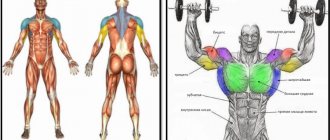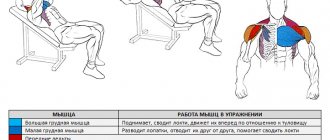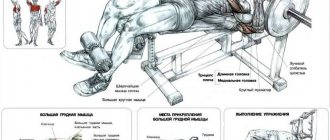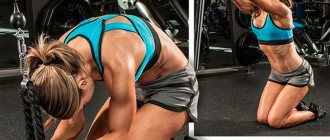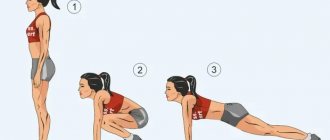For detailed development of the pectoral muscles, the Svend press is used. This exercise is widely used in bodybuilding. With it, you can effectively pump your chest at an unusual angle in a way that cannot be done using regular dumbbells or a barbell.
The Svend press cannot be called a strength exercise. It belongs to the formative ones. When performing it, it is important to feel how the muscles work, the neuromuscular connection is taken into account.
Technique
Performing the Svend press is not difficult. But when mastering the technique, the first repetitions are best done without using weights. Know that even professional athletes in exceptional cases reach serious heavy weights. The optimal weight is 2 pancakes of 10 kilograms each.
The technique is as follows:
- We take the starting position. We place our legs at shoulder level. Keep your back straight. We direct our gaze forward. We straighten our shoulders. We hold weight discs between our palms, next to our chest. They should be located vertically, perpendicular to the floor surface.
- We carry out the movement while exhaling. Gently straighten your arms, stretching them forward. We move strictly horizontally. At the highest point, hold the weight for 1-2 seconds. Then we carefully return to the starting position.
Interesting fact. During the exercise, you need to squeeze your palms as tightly as possible. This provides additional stress on the pectoral muscles.
Nuances
Performing the training involves taking the starting position while holding plates in your palms. The removal of the arms from the chest occurs due to the straightening of the elbow joints, the tension of the chest tissue allows you to hold the pancakes together. Beginners are recommended to start training with one disc, maximum 2.5 kg, pros - 5. Development of skills and muscle tissue leads to an increase in the number of discs and weight. Also, sports medical specialists do not advise operating with weights of more than 15 kg, which is equal to three disks.
The Norwegian strongman press also involves some safety rules. Not recommended:
- fill the holes of the pancake with your fingers, this is fraught with possible injury and a decrease in the tension of the chest tissues;
- abduct the arms downwards, only upwards;
- fully extend the elbow joint, the positive final phase is characterized by some bending;
- perform the exercise without prior appropriate preparation or warm-up; failure to comply with the rules leads to cramps of the pectoralis major muscles;
- perform initial approaches with large weights: 2.5 kg for a beginner, 5 for a professional;
- compensate for low weights with a large number of repetitions and cheating.
It is advisable to carry out the exercise after completing a set of exercises on the chest; reducing the weight will lead to the uselessness of the exercises.
Recommendations
By following these recommendations, you will get much more positive effect from the press:
- In order to shift the load to the chest area as much as possible, we try to keep our shoulders and forearms in a position parallel to the floor. The lower the elbows, the more non-target muscles are included in the process - the anterior deltoids and biceps.
- In some cases, it is possible to move the weights along an upward trajectory. But in the process, the shoulders come into play. If there is no goal to emphasize the load, you can successfully practice this method of performing the Svend press.
- There is no need to help with weight lifting on your back. Stretching and contracting movements of the latissimus muscle greatly simplify the process, which negatively affects the results.
- We perform the exercise without pauses. We maintain a slow, calm pace, but do not stop at all. We constantly keep our muscles in good shape.
- If your hands slip, we recommend wearing gloves. This way you will stay healthy, avoid injury and maintain maximum technique.
- If during the exercise you cannot maintain the trajectory, we advise you to reduce the weight to a comfortable one, at which your arms will not “walk.”
What can be replaced
The absence of a barbell at home is compensated by the dumbbell press. The difference is that the latter must be located simultaneous to one another. Holding them tightly parallel will allow the hands not to diverge to the sides, thereby ensuring the correct execution of the method.
The dumbbell exercise also allows you to add a little more weight to the dumbbells, as opposed to barbell plates. But training with pancake substitutes is fraught with giving up, which cannot even be called a free interpretation.
Advantages
- The Svend press is not a foundation or foundation. However, it perfectly strengthens the pectoral muscles and helps increase strength.
- When performing a bench press, your grip strength develops significantly, which is good for barbell bench presses or rows for the back muscle.
- The Svend press is often recommended for girls to restore breasts after childbirth and breastfeeding. This exercise perfectly tightens a “tired” bust.
- Using a bench press, you can shape the outline of your chest.
- The exercise is easy to master. It is not necessary to take heavy weights. Small pancakes are enough for successful work.
Interesting fact. The only noticeable drawback is the load on the ligaments of the chest and deltas. Many athletes experience discomfort when performing the exercise.
Inclusion in the training program
The Svend press is a more formative exercise. Therefore, it is mainly used at the end of a workout. Finishing off their pectoral muscles. But not everyone will be able to do this. Just imagine what you will feel like after heavy basic exercises, when you are already tired. We need to do one more exercise where the chest is in constant tension. And not 1 approach, but 3-4 for 10-15 repetitions. For me, this is just self-mockery.
It would be more rational to use it in the middle of a workout. Replacing the LYING DUMBBELL FLIES or CROSSOVER HANDS.
Also, many people do the Svend press before the basic ones. To fatigue the pectoral muscles. In short, you have the task of experimenting. And choose the optimal operating mode for yourself. And starting from it, find a place for this exercise.
As you can see, the Svend press has every right to exist. And our task is to restore it to its former glory.
Source
Basic mistakes
- Excessive weight. The most common mistake made not only by beginners, but also by experienced athletes. The Svend press is not a weight gain exercise. It is intended for completely different purposes, so there is no point in taking heavy weights. This is only fraught with herbs.
- Relaxation of the chest muscles. If fatigue occurs during the process, you must immediately stop performing the exercise. We take a short rest, reduce the weight, and finish off the remaining approaches. If you don’t follow this and stubbornly continue to press through the pain, there is a high probability of dropping the pancakes and injuring your legs.
- Converting the exercise into an arm extension. Another popular mistake. Many athletes bend their arms rather than pull their shoulders back, as the technique should. As a result, the load shifts to the biceps area.
Author of the exercise
Let's say a few words about the history of the exercise and its inventor. The name is deservedly given in honor of Svend Carlsen, a Norwegian bodybuilder and strongman. Many people remember this charismatic athlete thanks to the cry “Viking Power!”, which he shouted during competitions.
The Svend press was at one time very popular among athletes, but subsequently moved into the category of “forgotten exercises of the past.” Since then, many other effective exercises have appeared, but this bench press is still worth trying.
Perhaps if you diversify your chest training by adding it to the program (especially if the muscles are accustomed to the load), this will allow you to overcome stagnation and achieve the desired progress.
Options for performing the Svend press
In addition to the classic standing press, there are several other ways to perform the exercise:
- Lying down with a disc. This version of the press differs from the classic one only in its position in space. The movements are carried out while lying on a horizontal bench. But you need to understand that if you lose control over the weight, your chest and face will come under attack. And this is more dangerous than leg injuries.
- In the Smith machine. The exercise is rarely performed in this format. But sometimes it's justified. To perform, we lie down on a bench along the bar. We grab it with both hands (one higher than the other). From the accepted position we squeeze the projectile.
Svend press. What, why and why?
Note: For better assimilation of the material, all further narration will be divided into subchapters.
Muscle atlas
The exercise belongs to the class of conditionally isolated exercises and is aimed at working out the chest. The muscle ensemble includes the following units:
A complete muscle atlas looks like this:
Advantages
By performing the Svend press exercise, you can expect to receive the following benefits:
Execution technique
The Svend press is an exercise of entry-level complexity. The step-by-step execution technique is as follows:
Step #0.
Take a weight plate of the required weight in your hands and hold it between your palms, placing your bent arms near the middle of your chest. Use your hands to constantly apply pressure to the pancakes. Statically tighten your abs, place your feet shoulder-width apart, and bend your knees slightly. This is your starting position.
Step #1.
Inhale and as you exhale, extend your arms straight out in front of you, strictly horizontally. As you inhale, return to IP. Repeat the specified number of times.
In the picture version it looks like this:
In motion like this (fast mode):
Variations
In addition to the standard version of the Svend press, there are several variations of the exercise:
Secrets and subtleties
To get the most out of the exercise, follow these guidelines:
We're done with the theoretical side, now let's look at some practical points.
Is the Svend press an effective exercise for the chest?
First of all, athletes performing this exercise should understand that it is not a mass-gaining exercise, i.e. You cannot increase your pectoral muscle mass with it. It is advisable to use it exclusively as a preliminary fatigue, either in a superset, or after performing basic/conditionally basic exercises. For example, bench press or dips.
In this way, breasts will benefit from it: improved shape, internal detailing/detailing, fullness.
How to pump up a girl's breasts at home?
Men and women have different meanings for the term “pump up”. The latter is important to tone, tighten the chest muscles, and improve its shape. To achieve these goals, use the following training scheme:
Use this “homework”, and after a while your breasts will look much better.
Actually, we’re done with the substantive part of the note, let’s move on to...
Afterword
The Svend press is another exercise for our software arsenal. It is extremely important to give the muscles not only dynamic, but also static, isometric loads. Svendetz
